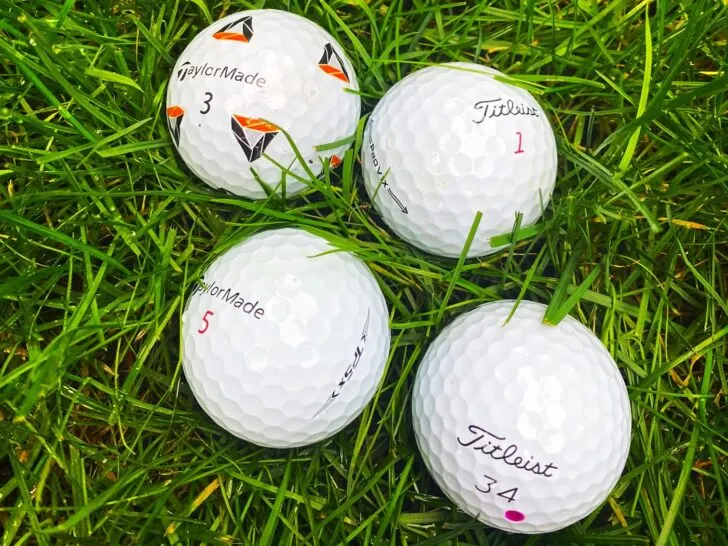The numbers on a golf ball are there solely for identification purposes.
They are called play numbers and they give the player a way to identify their golf ball.
Most serious players, and indeed all professional players, will take further steps to ensure that there is no doubt as to which ball is theirs.
They might use an uncommon ball number, such as the “99” Justin Rose uses or the “22” Rory McIlroy uses. Some, like Tiger and Rory, also put their name on the ball.
Others might put a unique mark on it in a specific color sharpie, such as the big pink dot Bubba Watson uses or the four red dots Justin Thomas draws.
How Are Golf Balls Numbered?
Most golf balls are numbered 1-4.
Each sleeve will be numbered differently in a typical box of a dozen golf balls. One sleeve will have three balls with the number 1 on them; another will have three balls with the number 2 on them, etc.
Some manufacturers now allow custom numbering where you can choose which number you want on your golf ball, typically between 00-99.
Related: What Are X Out Golf Balls?
What Do The Red And Black Numbers Mean On A Golf Ball?
In the old days, red-numbered balls signified a ball with a compression rating of 90, while black-numbered balls signified a compression rating of 100.
No one does this anymore, but many manufacturers do use red and black numbers to differentiate between different types of balls.
It appears that most manufacturers have flipped the color significance.
For example, ProV1x and TP5x balls have red numbers, while ProV1 and TP5 balls have black numbers.
For many manufacturers, red numbers signify a firmer feel and black numbers signify a softer feel.
This is the opposite of what the colors used to mean.
What Do Two-Digit And Three-Digit Numbers On Golf Balls Mean?
Today they mean nothing because they don’t exist anymore.
Many other articles on the topic talk about how two-digit numbers were used to signify the compression of the balls, and three-digit numbers indicated the number of dimples on the ball. While this is true, neither has been used in over 20 years, so who cares?
The only place you might see a golf ball with numbers that indicate its compression or number of dimples is on eBay.
The play number, or identification number, which can range from 00-99, is the only number you will see on modern golf balls
How To Identify A Golf Ball
- The Brand
- TaylorMade, Titleist, Bridgestone, Callaway, etc.
- The Type
- TP5x, ProV1, Tour B XS, Chrome Soft X, etc.
- The Number
- Typically 1-4, but it really can be any one or two-digit number
- Any Special Markings
- Alignment lines, unique markings, specific number/color/orientation of dots, etc.
If I were playing with a friend and I was playing a TP5x, and he was playing a Titleist ProV1, we would have no trouble differentiating our balls from one another.
Let’s say mine was a number 4, and I put three green dots on it.
The number and additional markings might come into play if I hit my ball in the woods.
Since I stated I was playing a number 4 with three green dots, I couldn’t just wander around in the woods until I found any old TP5x and claimed that as my own.
Related: Golf Ball Dimensions And Size
Why Is Identifying A Ball Important?
Clear and irrefutable proof that you are playing the correct ball is crucial, particularly in tournament play.
In stroke play, the penalty for hitting the wrong ball is two strokes, and the player must realize their mistake before they tee off on the next hole.
If not, they are disqualified.
In match play, you automatically lose that hole if you play the wrong ball.
Anytime a player switches what ball they are playing during a tournament, they will show their competitor and announce what brand and type of ball they are using, what number it is, and any additional markings they put on it.
Related: Most Expensive Golf Balls

